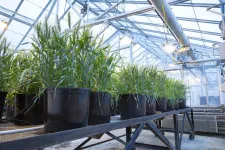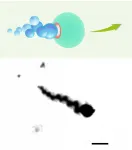'Trending' doctors' notes could help hospitals predict COVID-19 surges
Data mining technology developed by researchers at the NIHR Maudsley Biomedical Research Centre could help hospitals plan for surges in COVID-19 cases, based on notes recorded electronically by doctors.
2021-02-24
(Press-News.org) A new study, published today in Nature Digital Medicine, found that 'natural language processing' (NLP) of information routinely recorded by doctors - as part of patients' electronic health records - reveal vital trends that could help clinical teams forecast and plan for surges in patients.
The researchers from King's College London, King's College Hospital NHS Foundation Trust (KCH), and Guy's and St Thomas' Hospital NHS Foundation Trust (GSTT), used NLP algorithms to translate the electronic notes made by doctors into a standardised, structured set of medical terms that could be analysed by a computer.
Tracking trends in patients
In the same way social media posts can be tracked and aggregated by 'hashtags', the researchers detected words or phrases that were 'trending' in electronic health records at KCH and GSTT, during key stages of the COVID-19 pandemic last year. For instance, they tracked the number of patient records containing keywords for symptomatic COVID-19, such as 'dry cough', 'fever' or 'pneumonia'. Throughout the pandemic, hospital doctors have entered patient symptoms and test results into electronic health records, which are used to track the spread of COVID-19 at a national level.
However, these records often contain incomplete and unstructured data, that is difficult to access and analyse.
By analysing the text as a 'bag of words', the researchers were able to produce real-time maps of trending 'signals' (i.e., symptoms that were most frequently recorded by doctors), and these signals closely mirrored patterns of positive laboratory tests reported by each hospital. Clear spikes were visible in March 2020, for instance, during the first wave of COVID-19 cases, and in subsequent waves.
Providing advance warning for hospitals
The study indicates that these signals provide a real-time situational report of reflecting current activity levels in a hospital and up to four days advance warning for hospitals helping them to prepare for surges in COVID-19 admissions.
The study authors also reported a strong association between the trending signals and regional tracking of COVID-19 admissions in London hospitals. In addition, they found that as new COVID-19 symptoms emerged nationally, these symptoms were also recorded more frequently by doctors at KCH and GSTT.
Dr James Teo, Clinical Director of AI at King's College Hospital and Guy's and St Thomas' Hospital, said: "By teaching computers how to read and understand doctors' notes, we hope to reveal important patterns and trends that could help in the fight against COVID-19 and other diseases.
Tracking word trends in electronic health records offers an additional method for studying disease and healthcare activity, in a way that is very easy and cost-effective to run. While this method was shown to be effective in two individual hospital Trusts, the approach could be scaled up to a regional or even national level with the right privacy safeguards".
CogStack
The CogStack platform used in this study allows researchers to interrogate complex sets of data extremely rapidly, providing a real-time feed of what is happening in a particular hospital, allowing clinical teams to prepare for incoming patients.
Professor Richard Dobson, Head of the Department of Biostatistics & Health Informatics, NIHR Maudsley BRC, said: "The CogStack platform allows us to extract information from deep within hospital records at King's College Hospital NHS Foundation Trust in near real time. This means we can anticipate likely increases in pressure on the system before receiving information such as test results, giving clinical teams time to react and prepare in advance."
INFORMATION:
Acknowledgments
The platforms behind this research was funded by the National Institute for Health Research (NIHR) Maudsley Biomedical Research Centre (BRC), Health Data Research UK, UK Research and Innovation, London Medical Imaging & Artificial Intelligence Centre for Value Based Healthcare, Innovate UK, the NIHR Applied Research Collaboration South London, the NIHR University College London Hospitals Biomedical Research Centre and King's College London.
The researchers thank all the patients who agreed to their data being used for research, and the patients of the KERRI committee.
ELSE PRESS RELEASES FROM THIS DATE:
2021-02-24
Social distancing - from mobility restrictions to complete lockdowns -- can take many weeks, possibly even months, a potentially devastating outcome for social and economic stability. One of the challenges is that the sick cannot be selectively isolated, since many of the spreaders remain pre-symptomatic for a period ranging from several days to as much as two weeks - invisible spreaders who continue to be socially active. Hence, it seems that without a population-wide lockdown isolating the carriers cannot be achieved effectively.
To bypass this challenge, researchers from Israel's Bar-Ilan University, led by Prof. Baruch Barzel, devised a strategy based on alternating lockdowns: first splitting the population into two groups, then ...
2021-02-24
LOGAN, UTAH -- One solution to agriculture's many challenges -- climate change-induced drought, less arable land, and decreased water quality, to name a few -- is to develop smarter fertilizers. Such fertilizers would aim not only to nourish the plant but also to maximize soil bacteria's positive effects on the plant. Tapping into a plant's microbiome may be the extra layer of defense crops need to thrive.
In their study published on Dec. 4 in Nature: Scientific Reports, researchers at Utah State University analyzed the effects of two abiotic stressors on Pseudomonas chlororaphis O6 (PcO6), a health-promoting bacterium native ...
2021-02-24
URBANA, Ill. ¬- In today's global economy, production of goods depends on inputs from many trade partners around the world. Companies and governments need a deeper understanding of the global value chain to reduce costs, maintain a profitable production system, and anticipate ripple effects of disruptions in the supply chain.
Applied economists from the University of Illinois have developed a new model for in-depth analysis of global supply chain linkages across countries and industries, providing a rich tool that delivers valuable insights for businesses and policy makers around the world.
"We live in a time when production processes are very much fragmented. In order to end up with one type of ...
2021-02-24
Researchers have developed a method to estimate the value of oyster and clam aquaculture to nitrogen reduction in a coastal community. Nitrogen is a nutrient that comes from many different sources, including agriculture, fertilizers, septic systems, and treated wastewater. In excess it fuels algal growth, which can affect water quality and human health.
As a result, a growing number of communities are required to follow regulations to reduce the amount of nitrogen they release. Shellfish are an option that can be a valuable part of a community's nutrient management plan.
In a study in Environmental Science ...
2021-02-24
A UNSW Sydney-led medical research team has called for a new vaccine, improved strategies and enhanced monitoring to combat serious complications from childhood pneumonia.
The researchers examined the impact of the 13-valent pneumococcal conjugate vaccine (13vPCV) on childhood pneumonia and empyema - complicated pneumonia - after its introduction to the Australian National Immunisation Program about a decade ago.
The new study, published in Thorax recently, found that while 13vPCV resulted in a 21 per cent decrease in childhood pneumonia hospitalisations, there was a contemporaneous 25 per cent increase in admissions for empyema.
This incidence data for childhood empyema hospitalisations is similar to that reported ...
2021-02-24
For many, 2020 was notorious for the COVID-19 pandemic, but for climate scientists, the year is also infamous for tying with 2016 as the hottest since records began. 'Nine of the warmest years on record have occurred since 2010', says JEB Editor-in-Chief, Craig Franklin. With the ice caps and glaciers melting, devastating bushfires scorching arid regions, and hurricanes and typhoons battering coastal communities, the impact on local ecosystems has been catastrophic. 'Physiologists can play a critical role in the conversation around climate change', says ...
2021-02-24
As part of the Journal of Experimental Biology's Special Issue dedicated to climate change, Anthony Pagano (San Diego Zoo Global, USA) and Terrie Williams (University of California, Santa Cruz, USA), discuss the impact of environmental change on two iconic polar species; the polar bear and narwhal. Their review article is published in Journal of Experimental Biology at https://jeb.biologists.org/content/224/Suppl_1.
Mammals in the Polar Regions face an uncertain future as unprecedented warming drives catastrophic sea ice loss, driving polar bears onto land, after losing access to sea ice and ...
2021-02-24
Rheumatoid arthritis is a chronic inflammatory disorder marked by joint pain, swelling and damage. Although medications, such as steroids, anti-inflammatory drugs and immunosuppressants, can help slow joint destruction and relieve pain, they have side effects and aren't completely successful. Now, researchers reporting in ACS' Nano Letters have developed magnesium-based micromotors propelled by hydrogen bubbles, which improved rheumatoid arthritis symptoms when injected into the joints of rats.
Scientists have linked rheumatoid arthritis development to the excess production of reactive oxygen species (ROS). ROS can oxidize and degrade cartilage and bone, as well as activate the expression of inflammatory cytokines. A new type of therapy, hydrogen gas, can neutralize ROS ...
2021-02-24
To come into being, galaxies need a steady diet of cold gases to undergo gravitational collapse. The larger the galaxy, the more cold gas it needs to coalesce and to grow.
Massive galaxies found in the early universe needed a lot of cold gas--a store totaling as much as 100 billion times the mass of our sun.
But where did these early, super-sized galaxies get that much cold gas when they were hemmed in by hotter surroundings?
In a new study, astronomers led by the University of Iowa report direct, observational evidence of streams of cold gas they believe provisioned these early, massive galaxies. They detected cold gas pipelines that knifed through the hot atmosphere in the dark matter halo of an early massive galaxy, supplying the materials ...
2021-02-24
New research by the University of Oslo provides evidence that the "protocells" that formed around 3.8 billion years ago, before bacteria and single-celled organisms, could have had specialized bubble-like compartments that formed spontaneously, encapsulated small molecules, and formed "daughter" protocells.
ROCKVILLE, MD - Scientists have long speculated about the features that our long-ago single-celled ancestors might have had, and the order in which those features came about. Bubble-like compartments are a hallmark of the superkingdom to which we, and many other species including yeast, belong. But the cells in today's superkingdom have a host of specialized molecules that help make and shape these bubbles inside our ...
LAST 30 PRESS RELEASES:
[Press-News.org] 'Trending' doctors' notes could help hospitals predict COVID-19 surges
Data mining technology developed by researchers at the NIHR Maudsley Biomedical Research Centre could help hospitals plan for surges in COVID-19 cases, based on notes recorded electronically by doctors.




